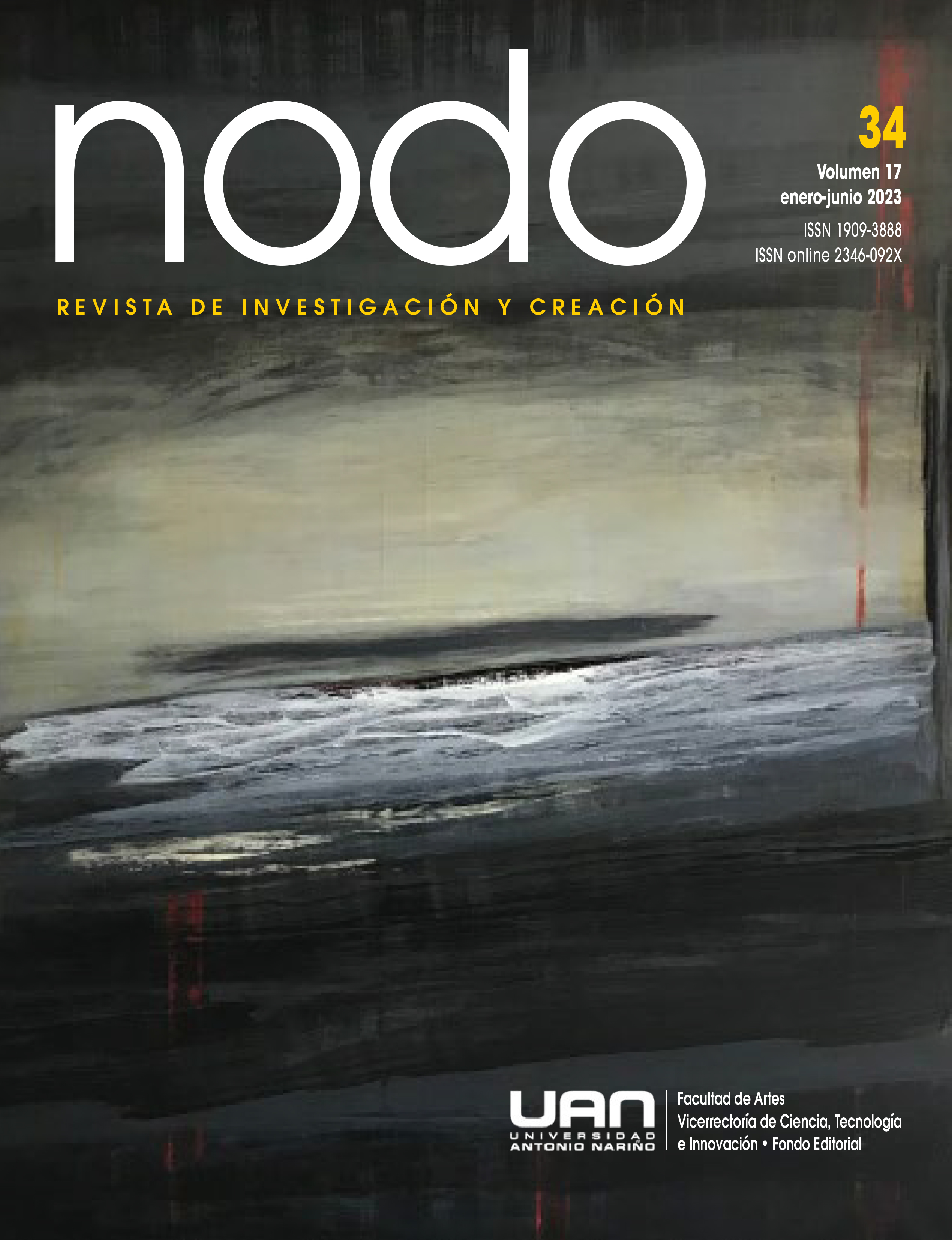Una reinterpretación tímbrica del espacio eco-acústico
Improvisación guiada a través del análisis del paisaje sonoro
DOI:
https://doi.org/10.54104/nodo.v17n34.1267Palavras-chave:
análisis sonoro-espacial, improvisación, paisaje sonoro, prácticas musicalesResumo
El presente trabajo expone un caso de estudio que utiliza al paisaje sonoro como guía interpretativa y analítica del espacio en el contexto de la composición y la improvisación musical. El artículo explora una metodología que permite estructurar e integrar el espacio como elemento compositivo. Diferentes músicos participaron en la tarea de elaborar un análisis intuitivo enfocado en la percepción del espacio o en los eventos sonoros con trayectorias espaciales. Esto fue posible con la utilización de la tecnología ambisonics, la cual permite apreciar con mayor fidelidad las características acústicas del espacio, así como diferentes eventos acústicos en movimiento que ocurren en el momento de la grabación. Se toma como referencia a los artistas Barry Truax (Canadá, 1947) y David Dunn (Estados Unidos, 1953), quienes han incluido el espacio en sus obras como elemento a interactuar por medio del sonido. Ambos artistas sirvieron como referente en las distintas estrategias que se pueden elaborar para interactuar con el espacio al emplear diferentes sonidos proyectados en el espacio. Se introduce la metodología que permitió acercarse al estudio del paisaje sonoro, así como los resultados obtenidos por los distintos integrantes del estudio. Todo esto con la finalidad de incorporar el espacio acústico como elemento musical a estudiar.
Downloads
Referências
Akiyama, M. (2010). Transparent Listening: Soundscape Composition’s Objects of Study. RACAR: Revue d’art Canadienne / Canadian Art Review, 35(1), 54-62. http://www.jstor.org/stable/42630819
Barrett, N. Spatio-musical composition strategies. Organised Sound, 7, 313-323. doi:10.1017/ S1355771802003114 (2002).
Braasch, J. et al. A Loudspeaker-Based Projection Technique for Spatial Music Applications Using Virtual Microphone Control. Computer Music Journal, 32 (3), 2008, 55-71. JSTOR, www.jstor.org/stable/40072647.
Cage, J. (2010). Cage Silence. Hearing Voices, Agosto de 1992. Transcript of the interview with John Cage in the film Ecoute (Listen) by Miroslav Sebestik. Web publish 3 Feb., hearingvoices.com/2009/09/cage-silence/. (accessed December 4, 2021).
Chion , M. (2015),.Las Tres escuchas. Es lo Cotidiano. November 21. https://www.eslocotidiano.com/articulo/tachas-128/escuchas/20151121102243025093.html
Dunn, D. (1983). Speculations: On the Evolutionary Continuity of Music and Animal Communication Behavior. Perspectives of New Music, 22 (1/2), 87-102. JSTOR, www.jstor.org/stable/832936
Dunn, D. (1988). Wilderness as Reentrant Form: Thoughts on the Future of Electronic Art and Nature. Leonardo, 21 (4), pp. 377-382. JSTOR, www.jstor.org/stable/1578700
Dunn, D., & Lampert, M. (1989). Environment, Consciousness, and Magic: An Interview with David Dunn. Perspectives of New Music, 27(1), 94-105. doi:10.2307/833258
Dunn, D. (2022). David Dunn: Mimus Polyglottos (1976) [Video]. January 03. YouTube. https://www.youtube.com/watch?v=i9veOLaHUzg&feature=youtu.be
Hoose, S. (2015). Creating Immersive Listening Experiences with Binaural Recording Techniques. College Music Symposium, 55. JSTOR, www.jstor.org/stable/26574394
Hron, T. (2014). Useful Scores: Multiple formats for electro acoustic performers to study, rehearse and perform. Organised Sound, 19 (03), diciembre, 239-243. doi: 10.1017/S1355771814000223, Published online: 13 November.
Kendall, G. (2010). Spatial Perception and Cognition in Multichannel Audio for Electroacoustic Music Organised Sound, 15 (03), diciembre, pp 228-238. doi: 10.1017/S1355771810000336, Published online: 25 October 2010.
Krause, B. “Transcript of ‘The Voice of the Natural World.’” TED, May 2014. www.ted.com/talks/bernie_krause_the_voice_of_the_natural_world/transcript#t-156303. (last accessed May 31st 2023).
Pijanowski, B. C., Villanueva-Rivera, L. J., Dumyahn, S. L., Farina, A., Krause, B. L., Napoletano, B. M., Gage, S. H., & Pieretti, N. (2011). Soundscape ecology: The science of sound in the landscape. BioScience, 61(3), 203-216. https://doi.org/10.1525/bio.2011.61.3.6
Truax, B. (1998). Composition and diffusion: space in sound in space. Organised Sound, 3(2), 141-146. https://doi.org/10.1017/s1355771898002076
Truax, B. (2001). Islands. Cambridge Street Publishing, CSR-CD 0101 (Pendlerdrøm). World Soundscape Project. 1997. The Vancouver Soundscape. Cambridge Street Publishing, CSR-2CD 9701
Truax, B. (2008). Soundscape Composition as Global Music: Electroacoustic music as soundscape. Organised Sound, 13(2), 103-109. https://doi.org/10.1017/S1355771808000149
Truax, B. (ed.) (1999). Handbook for Acoustic Ecology. Cambridge Street Publishing, CSR-CDR 9901 (Sound- scape examples).
Downloads
Publicado
-
Resumo340
-
PDF (Español)51
Como Citar
Edição
Seção
Licença
Copyright (c) 2023 Pablo Rubio Vargas, Jorge Rodrigo Sigal Sefchovich

Este trabalho está licenciado sob uma licença Creative Commons Attribution-NonCommercial-ShareAlike 4.0 International License.




 Portal de Ciencia Abierta
Portal de Ciencia Abierta